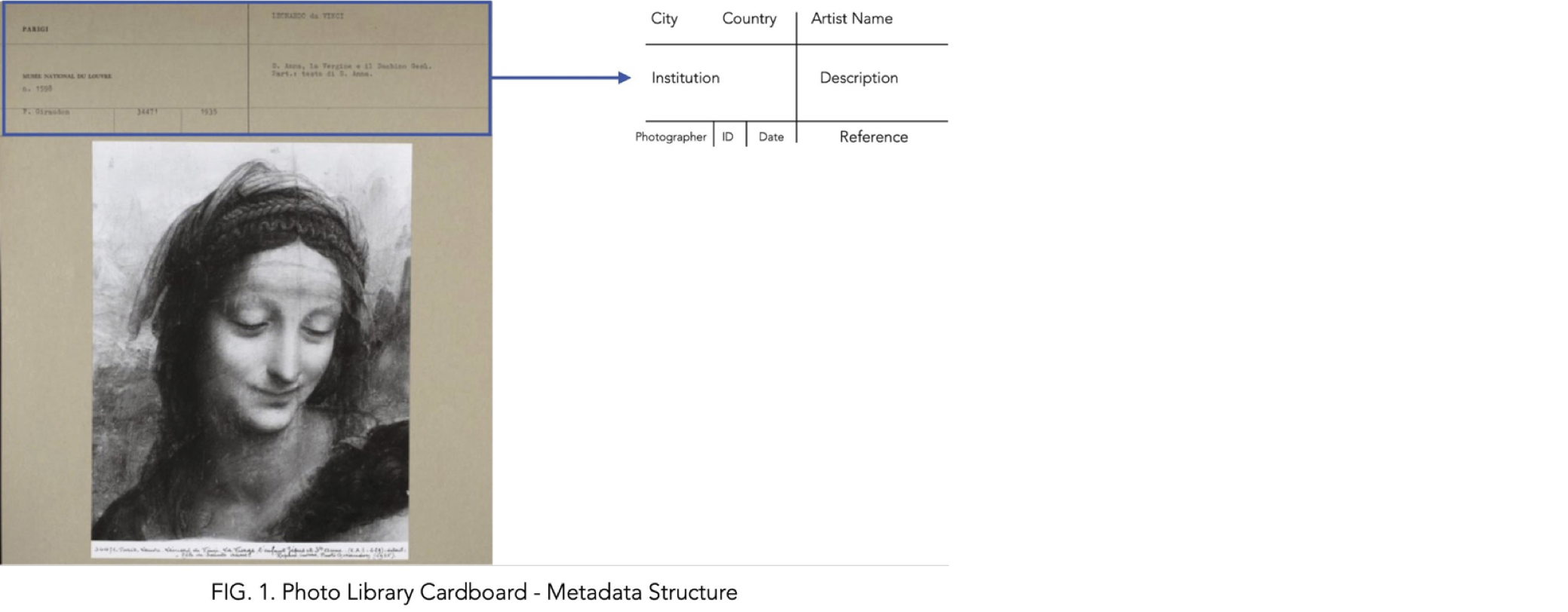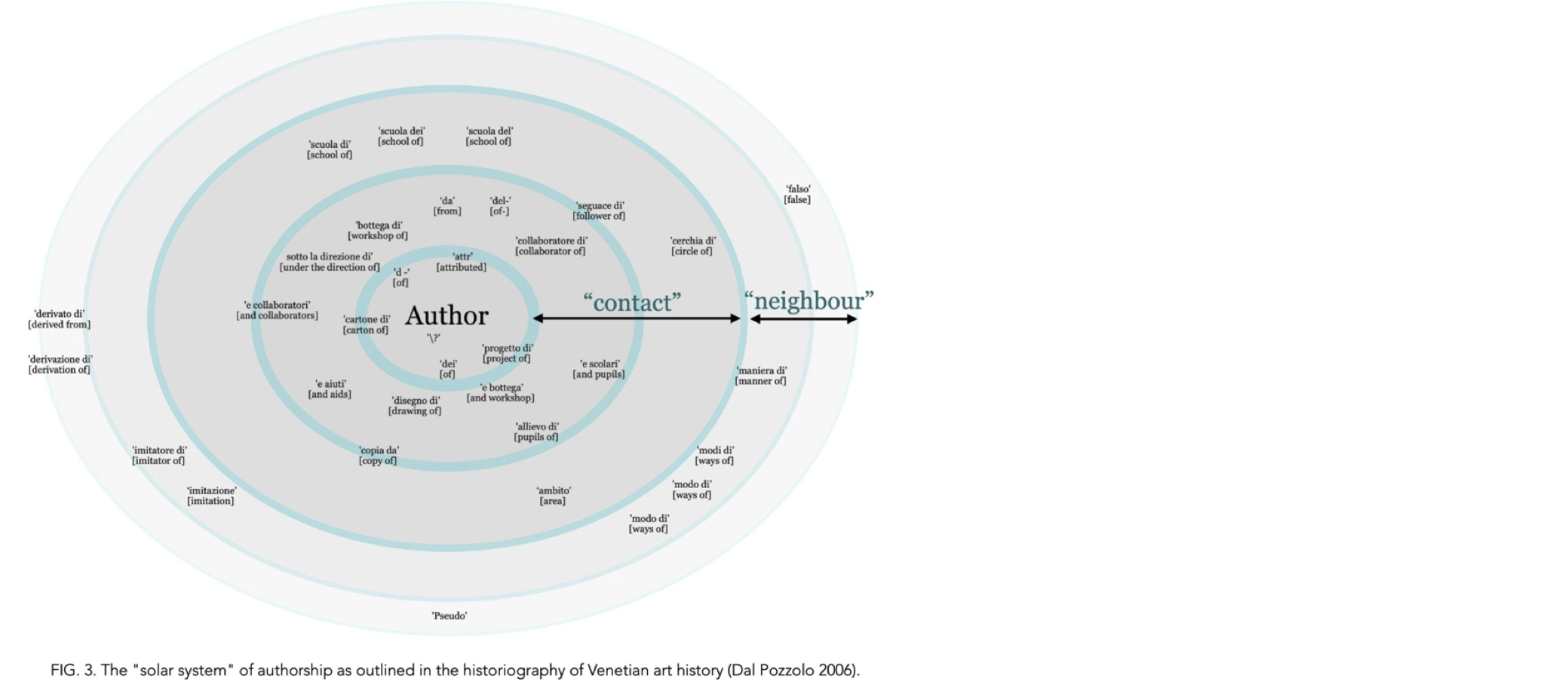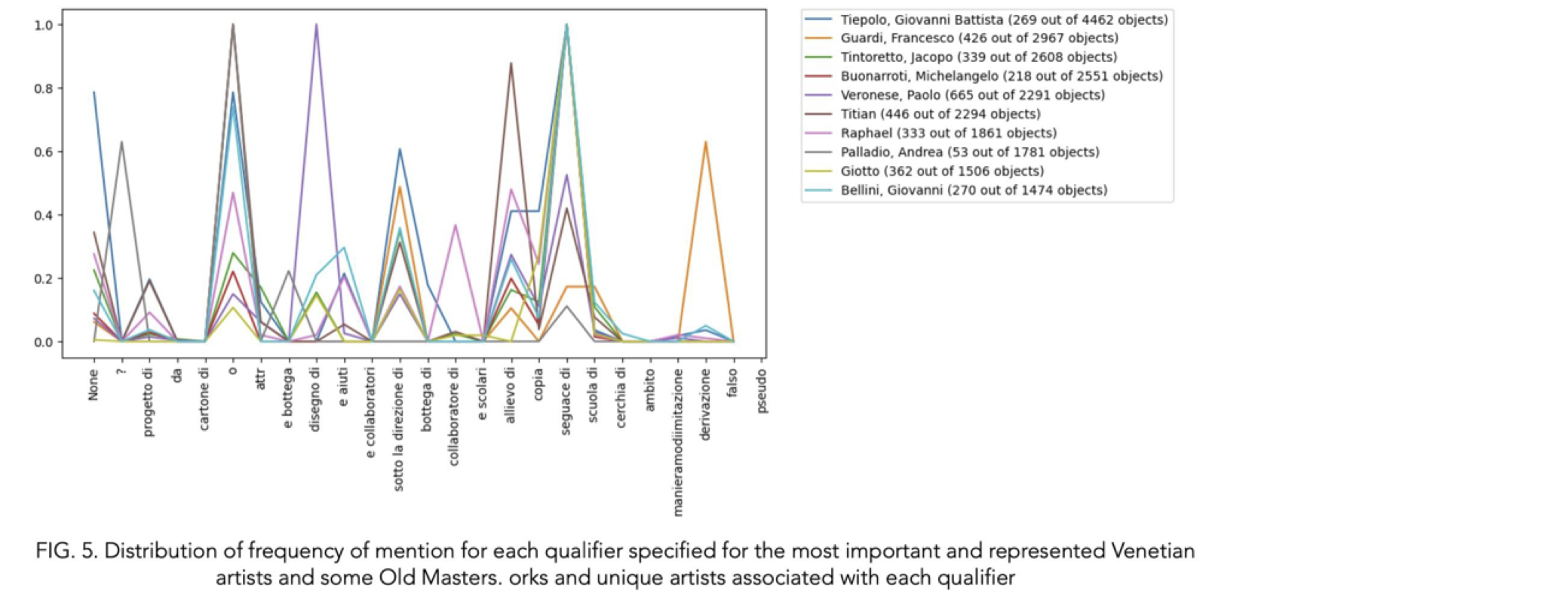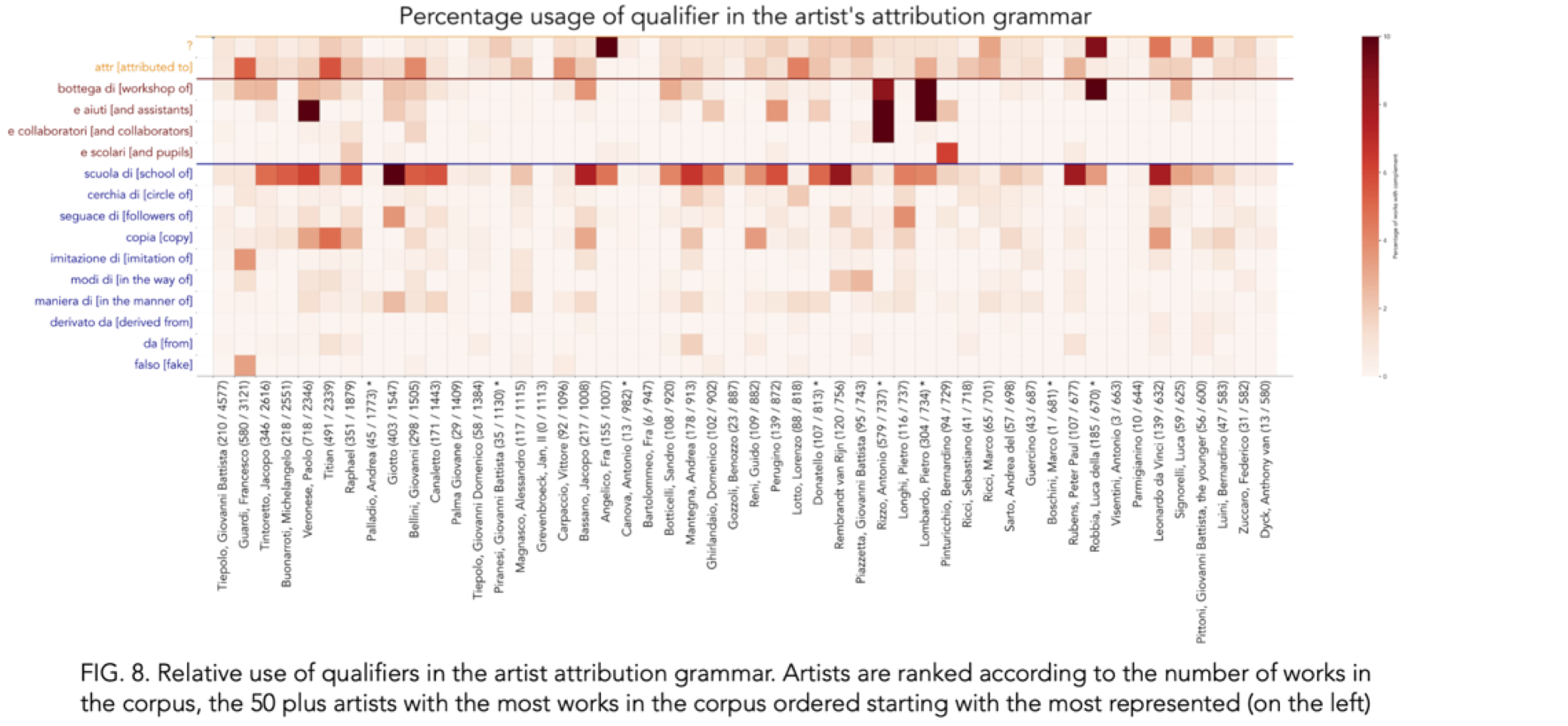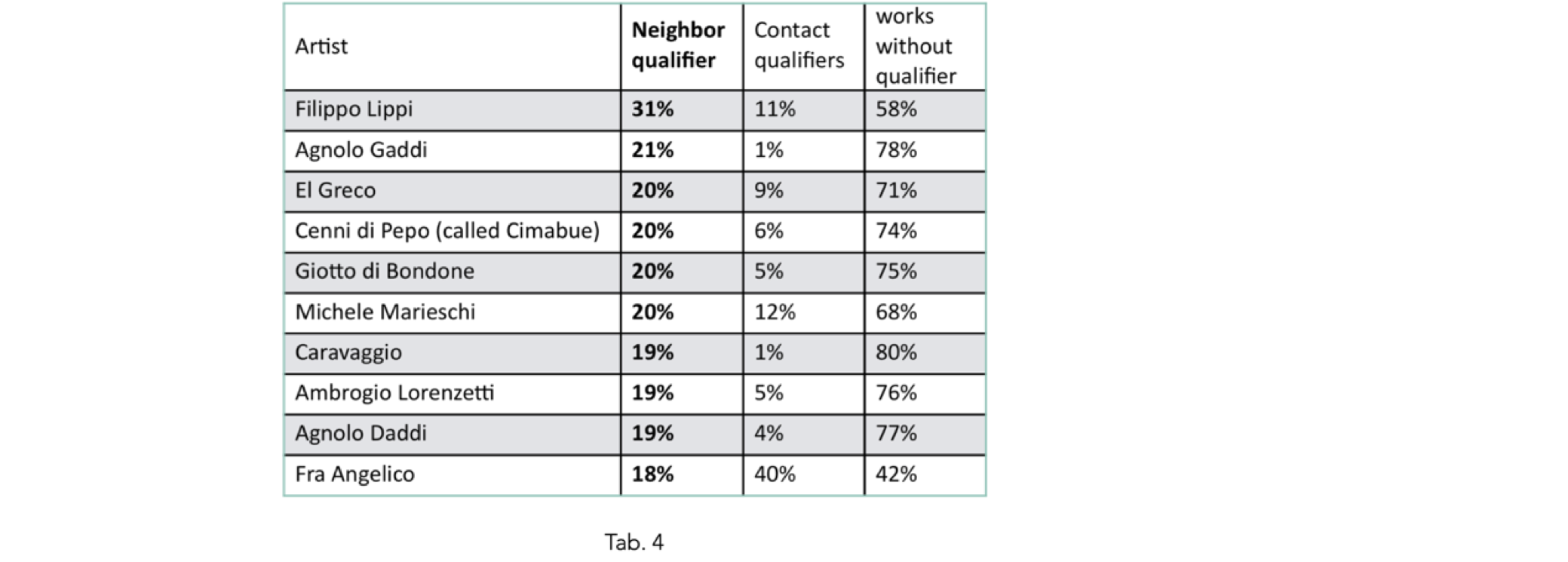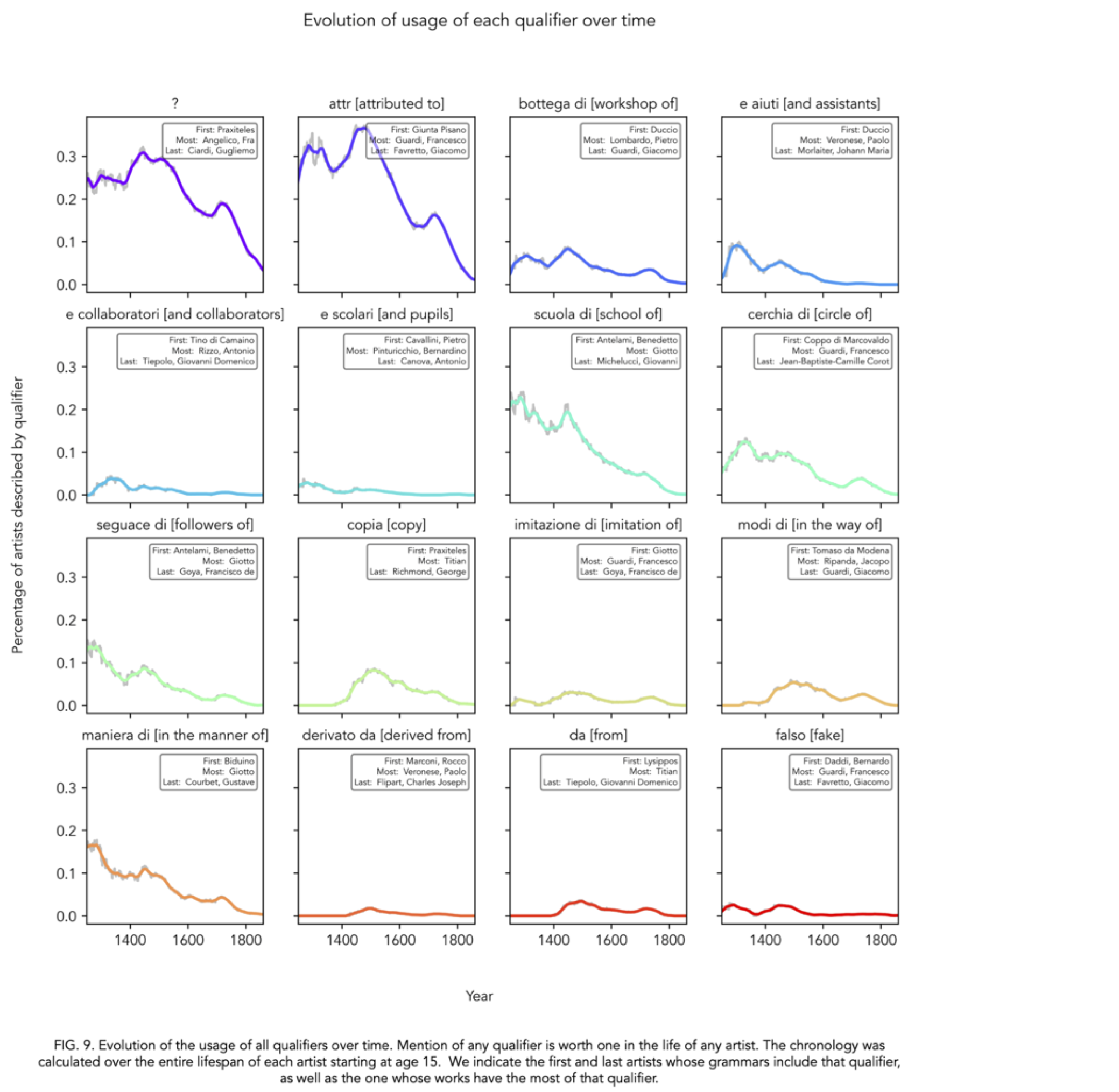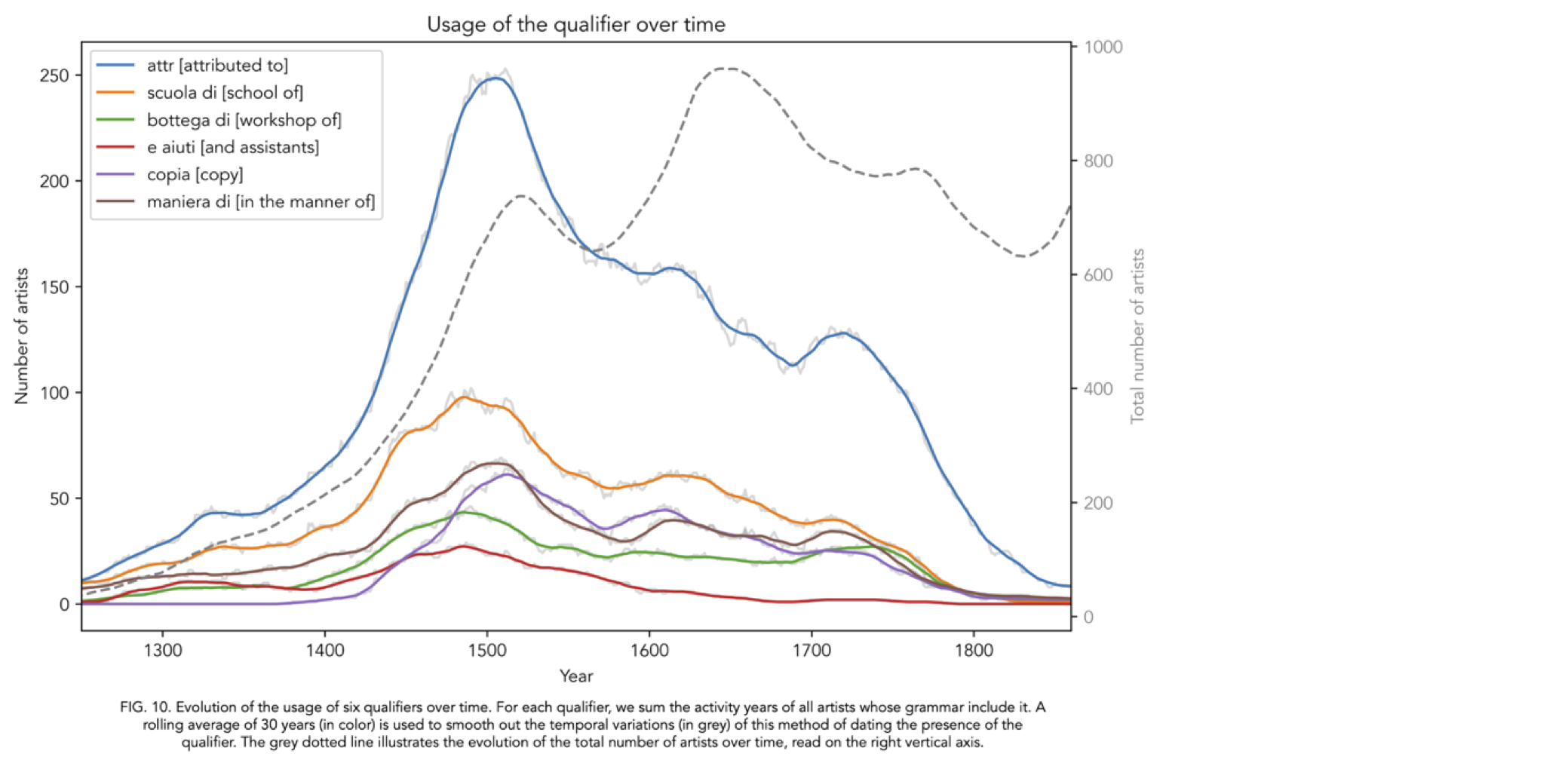1.
Introduction
Since 2015 Digital Humanities Laboratory at École Polytechnique Fédérale de Lausanne and the Cini Foundation (Venice) collaborated on the "Replica" project, aiming to digitize the Institution's vast photo library, a crucial resource for art and photography history. About one million images of cardboard were digitized from collections gathered by the Institute of Art History's conservators and directors over decades (di Lenardo 2022).
Each photo is attached to cardboard containing essential information, structured by fields, manually or typewritten by the Institute's conservators. This data extraction from the cardboard aims to establish a comprehensive index of metadata of the collection, previously non-existent (Seguin 2018). The field concerning "artist name" has been extracted through OCR (Optical Character Recognition) and the complex structure of its grammar has been analyzed (Fig.1). The primary objective is to showcase how distant analysis of the attribution grammar, residing within the "artist name" field, contributes to formulating a data-driven theory regarding the paths of authors and their artistic trajectory. The "artist name" field holds more than mere identification; it encompasses a rich taxonomy of ‘qualifiers’ that characterize the quality and nature of authorship. The analysis of these qualifiers through quantitative methods unveils distinct artistic trajectories and the evolution of attribution in art history.
This distant view offers insights into the historical context surrounding artists, unveiling the function of the author as a meta-historical device, elucidating artistic production within specific historical eras or established historiographies.
2.
Background and significance
The exploration of evolving art historical taxonomy through qualifiers regarding authorship lacks comprehensive study. Art History traditionally covers original authorship, workshop
roles, and stylistic propagation and the focus tends towards individual artists and specific workshops, rather than comparable across periods and artists (Tagliaferro et al. 2009; Loh 2007 ; Hansen 2013; Van Den Brink 2001; Auwera et al. 2007). Still unstudied is the evolutionary history of the use of taxonomies to characterize the authorship. At the same time, standardizing a vocabulary of qualifiers is the concern of digital photo-libraries that re-document, at different times, the state of historiographical debate (‘Getty Vocabulary Program Ontology’; Bülow, Ahmon, and Spencer 2011).
A systematic approach using vast textual datasets could offer new insights into the nuanced evolution of attribution grammar across regions, time, art forms.
3.
Methodology
The digitization and subsequent realignment of authors' names from photo-archive cardboard presented multifaceted challenges and insights. Using the Getty Union List of Artist Names, this realignment offered a comprehensive overview of the Giorgio Cini Foundation's photo library, spanning from the 14th century to around 1900. This chronological span predominantly represented 52,402 single-authored cardboard out of 330,002, excluding misattributed earlier period items. The number of items represented in the photos that benefited from the realignment amounted to 176,729.
The realignment process uncovered numerous challenges: pseudonyms and regional spelling variations posed hurdles, especially for lesser-known artists (Seguin et al. 2018). Differences in naming conventions across countries and complexities arising from identical names across generations. Eliminating grammatical expressions focusing on periods e.g. "15th-century author" or periods e.g. “French school," which deserve specific analysis, the focus remained on establishing a database with qualifiers indicative of proximity or distance from the artist.
During analysis, 26 specific qualifiers emerged from the realigned unique authors (tab.1). By consolidating significant qualifiers, the study delineated an exhaustive list of 18 qualifiers that marked relationships, either in proximity or distance, with the respective artists (Fig 2). This process of aligning names enriched the collection's knowledge while revealing the intricate structure within authors' mentions, shedding light on the complex nuances and challenges in attributions due to varied naming practices and historical contexts.
4.
Results
Qualifiers accompanying an artist's name function as attribution modifiers, delineating a hierarchy within attributions. Taxonomy analysis, repositioning qualifiers hierarchically sheds light on varying attributions and artistic profiles. This analytical model, analogous to a 'solar system' of attribution, places qualifiers according to a conceptual logic of proximity or distance from the author, aligning with established art historical historiography (Dal Pozzolo 2006).
We systematically reorganized the qualifiers introduced by curators, delineating the author's involvement in relation to the artwork and the proximity of their direct engagement into two primary categories. 'Contact qualifiers' encompass instances of direct intervention by the author or other artists closely tied chronologically and geographically to the author's presence, potentially within their workshop or during their lifetime. On the other hand, 'Neighbour qualifiers' signify interventions by other artists further removed in time and space, outside the immediate purview of the author's influence.
This classification aids in categorizing the types of works linked to a specific artist, such as those originating from their workshop or school, and indicates the reception of the artwork through the critical lens, emphasizing recognizable styles or typical elements. Key qualifiers for example include terms like "copy" (indicating a replication of a work) and "manner of" or “school” (implying a stylistic derivation) (Fig. 4).
In the dataset, the presence of the author with uncertain attribution (with a question mark) constitutes the majority. Expressions like 'school of' also appear, suggesting a historical concept, implying an enduring transmission of artistic techniques or learning in the manner of an author in particular (Fig. 4). The most represented authors in terms of number of works in the photo library are, as we can probably expect from the Venetian photo library par excellence, Venetians and Old Masters counting more than 100 single items: Giambattista Tiepolo, Canaletto, Francesco Guardi, Titian Vecellio, Paolo Veronese, and Old Masters Michelangelo and Raphael (Fig. 5) .
Analyzing qualifiers across artists offers insights into entire artistic periods or disciplines like painting, sculpture, and engraving, revealing nuanced theories regarding artistic production.
It may highlight more famous authors by copy propagation of certain works (copy of) or by a diffusion of style (manner of) or by massive production (workshop of) or by a majority of coeval emulators (school of) (FIG. 6-7). We can say that contact qualifiers, which describe the presence of a group of collaborators around the artist, is an indicator of complex-large scale production activity, neighbor qualifiers are key indicators of visual impact fortunes.
Authors with the greatest variety of qualifiers include Giambattista Tiepolo (31), Canaletto and Rubens (30), Antonio Correggio (29), Raphael Sanzio and Jacopo Bassano (28). If we analyze the distribution of contact qualifiers or neighbors of the mentioned authors, we find that normalizing the number of qualifiers held on the number of works documented photographically, these Masters still have a small percentage compared to that of other artists (Tab. 2).
Among the top 50 artists by volume, Fra' Angelico stands out for the highest level of authorial uncertainty. Several sculptors like Luca della Robbia and Antonio Rizzo, alongside Paolo Veronese, exhibit notably active workshops (Fig. 8).
For artists with more than 100 works (Tab.3 – Fig. 6) the highest percentage of works with contact qualifiers are sculptors: Antonio Rizzo (76%), Orazio Marinali (46%), Nino Pisano (38%) and Pietro Lombardo (37%). This seems to be explained by a preponderance of attributed (i.e. uncertain) or workshop works. It would therefore be reasonable to assume that in the artistic practice of these authors, the workshop plays an important role: the works are produced in a repetitive, serial way, with a great expenditure of labor. The contact qualifiers highlight something related to "artistic making", to the practice of the activity carried out.
On the other hand, if we analyse the neighbour qualifiers in the top ten positions of authors with more than 100 works attributed (Tab.4), we find Agnolo Gaddi (21%), Cenni di Pepo (called Cimabue 20%), Giotto di Bondone (20%), Bernardo Daddi (19%), Ambrogio Lorenzetti (19%) and Fra Angelico (18%). The 14th century Tuscan, more precisely the
Trecento
Florentine, excluding Lorenzetti who is Sienese, and Fra Angelico born at the end of the century, is strongly represented. The pre-Renaissance artistic milieu in Florence is strongly characterized by derivative works (Tab. 4).
Among the authors counting many works described through qualifiers and very varied among them, there is Filippo Lippi : 11% of contact qualifiers and 31% of neighbour qualifiers. Analysis of the evolution of usage of each qualifier (Fig. 9) can reveal for which author in the Cini dataset, in chronological order, specific qualifiers appear: "Praxiteles" is the first uncertain authorship mentioned with "?" and for which "copies" appear, the most copied in the dataset is "Titian," and the last to have an active workshop is Giacomo Guardi (1764-1835).
Another analysis method can reveal linguistic evolution over time, showcasing how attribution qualifiers' language potentially mirrors distinct historical periods (Fig.10).
There’s a clear decline in artistic taxonomy qualifiers, indicating a shift from collective workshop endeavors to recognizing individual authors. Specifically, in the Cini dataset, the decline of "workshop of" by 1830 implies a transformation favoring independent artists and certainty in profiling authorship.
5.
Conclusion
Qualitative analysis of qualifiers is a key determinant in unraveling authorial trends in art history, delineating authorial practices (with or without workshops) and critical fortunes related to specific styles or works that assume value as masterpieces to be imitated. Examination of the chronological evolution of the taxonomy demonstrates important shifts in interpretations of art historiography, suggesting on the one hand the decline of workshop structures and the rise of well-documented individual identities, with 1830 as the pivotal date, as far as the Cini dataset is concerned, and on the other hand the end of the idea of copying and artistic influence as it was understood until the late 19th century. It would also be interesting, for further analysis, to examine this second trend in chronological and geographical relation to the definition of artistic copyright from a legal point of view. Expanding this type of methodology to other datasets that include geographically diverse authors will allow for further exploration of the dynamics of authorial fortune, profiling of artistic activity, and artistic propagation across time and space, as we introduced with this initial study.
References
Auwera et al. 2007
Auwera, vander Joost /et al. (2007),
Rubens: A Genius at Work : The Works of Peter Paul Rubens in the Royal Museums of Fine Arts of Belgium Reconsidered,
Lannoo: Uitgeverij.
Bülow, Ahmon, and Spencer 2011
Bülow, Anna / Ahmon, Jess / Spencer, Ross (2011):
Preparing Collections for Digitization :
Facet Publishing
di Lenardo 2022
di Lenardo, Isabella (2022) : “The Replica Project: Co-Designing a Discovery Engine for Digital Art History”, in
Multimodal Technologies and Interaction
6, no. 11 .100
https://doi.org/10.3390/mti6110100
.
Getty Vocabulary Program Ontology
https://www.getty.edu/research/tools/vocabularies/lod/ (last access : 07.12.2024)
Hansen 2013
Hansen, Morten Steen (2013) :
In Michelangelo’s Mirror: Perino Del Vaga, Daniele Da Volterra, Pellegrino Tibaldi,
University Park, Pennsylvania: Pennsylvania State University Press
Loh 2007
Loh, Maria H. (2007) :
Titian Remade: Repetition and the Transformation of Early Modern Italian Art,
Los Angeles : Getty Publications
Seguin 2018
Seguin, Benoit / Costiner, Lia / di Lenardo, Isabella / Kaplan, Frédéric (2018) : “Extracting And Aligning Artist Names in Digitized Art Historical Archives”, in
Book of Abstracts of Digital Humanities Conference 2018 Puentes-Bridges
Tagliaferro et al. 2009
Tagliaferro, Giorgio / Aikema, Bernard / Mancini, Matteo / Martin Andrew, John (2009) :
Le Botteghe Di Tiziano,
Firenze : Alinari
https://www.academia.edu/12525963/Le_botteghe_di_Tiziano_Firenze_Alinari_2009_
.
Van Den Brink 2001
Van den Brink, Peter (2001) :
L’Entreprise Brueghel
(Maastricht Bruxelles Gand Amsterdam: Bonnefantenmuseum Musées royaux des beaux-arts de Belgique), Ludion : Flammarion
